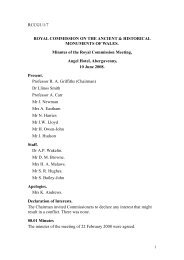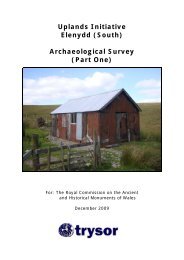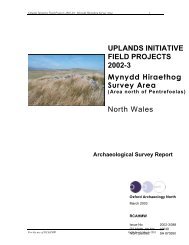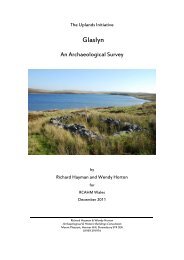Plynlimon (central) - Royal Commission on the Ancient and ...
Plynlimon (central) - Royal Commission on the Ancient and ...
Plynlimon (central) - Royal Commission on the Ancient and ...
You also want an ePaper? Increase the reach of your titles
YUMPU automatically turns print PDFs into web optimized ePapers that Google loves.
Upl<strong>and</strong>s Initiative - Nant y Moch & Pumlim<strong>on</strong> Fawr / <str<strong>on</strong>g>Plynlim<strong>on</strong></str<strong>on</strong>g> 2004‗Y Foel‘ or ‗The Bare topped hill‘ is a high steep sided bare hill that reaches a height of approx. 546mO.D. The curtained west facing slope is almost vertical <strong>and</strong> as such is always in <strong>the</strong> dark. At its westernbase is a small stream that runs southwards eventually reaching up with <strong>the</strong> Af<strong>on</strong> Castell to <strong>the</strong> south. Thishigh hill dwarfs a smaller hill to <strong>the</strong> west known as ‗Y Drum‘ or ‗The Ridge‘ <strong>and</strong> shades <strong>the</strong> <str<strong>on</strong>g>central</str<strong>on</strong>g> coreof <strong>the</strong> Sweet Lamb Rally Complex‘. In <strong>the</strong> shadow of ‗Y Foel‘ <strong>and</strong> at <strong>the</strong> sou<strong>the</strong>rn base of Y Drum is <strong>the</strong>deserted rural farmstead of ‗Cefn-brwyn‘Geology(see Fig 3)The exposed solid geology of <strong>the</strong> study area is predominantly that of Ordovician Ashgill with alithological ornament of ‗Greywacke‘ atop <str<strong>on</strong>g>Plynlim<strong>on</strong></str<strong>on</strong>g> <strong>and</strong> its low lying rock outcrops. To <strong>the</strong> east of<str<strong>on</strong>g>Plynlim<strong>on</strong></str<strong>on</strong>g> in <strong>the</strong> regi<strong>on</strong> of <strong>the</strong> village of P<strong>on</strong>terwyd <strong>and</strong> over towards <strong>the</strong> Powys regi<strong>on</strong>, <strong>the</strong> geology ispredominantly of <strong>the</strong> Silurian Ll<strong>and</strong>overy Series, of Telychain, Rhuddanian <strong>and</strong> Aer<strong>on</strong>ian types. A seriesof surface fault lines, generally of lead, run east-west <strong>and</strong> north-north-east to south-south-west across <strong>the</strong>whole of <strong>the</strong> study area(Ordnance Survey Geological Map of Great Britain, 3 rd series, 1979, 1:25,000).In terms of localised geological forms, <strong>the</strong>re exist b<strong>and</strong>s or veins of ferric white quartzite in <strong>the</strong> areas ofCraig y March <strong>and</strong> Cwm Gwerin (Area 12), particularly al<strong>on</strong>g its north <strong>and</strong> south facing slopes. Exposedveins of ferric white quartz are also visible in areas al<strong>on</strong>g <strong>the</strong> top platform areas to <strong>the</strong> east of Pumlim<strong>on</strong>Fawr (Area 9). A fur<strong>the</strong>r surface exposed seam is in <strong>the</strong> area near Maesnant (Area 8).As dem<strong>on</strong>strated by <strong>the</strong> extensive lead mining activity in <strong>the</strong> survey area, fault lines c<strong>on</strong>taining lead orecover much of <strong>the</strong> area. These faults run across <strong>the</strong> hill known as Drosgol (Area 1), through <strong>the</strong> formerNant y Moch valley <strong>and</strong> through <strong>the</strong> nor<strong>the</strong>rn areas of Pumlim<strong>on</strong> Fawr (Areas 2, & 9). In <strong>the</strong> Powysregi<strong>on</strong>, <strong>the</strong>se fault lines run through Bryn Daith, Esgair y Maen <strong>and</strong> Llechwedd Hirgoed (Areas 15, 16 <strong>and</strong>13). In <strong>the</strong> areas of <strong>the</strong> former Nant y Iago Lead Mine, seams of galena <strong>and</strong> white/grey calcite are alsoevident, particularly at <strong>the</strong> surface where <strong>the</strong>y have been heavily extracted al<strong>on</strong>g with lead ore.The east <strong>and</strong> west base of Pumlim<strong>on</strong> Fawr is heavily peat covered, with some areas having peat as deep as3.5m. This is particularly evidenced by <strong>the</strong> l<strong>and</strong>scape just east of ‗Pen Lluest-y-carn‘, where much of <strong>the</strong>peat has been dug away or else has eroded <strong>and</strong> left areas of peat bog. This particular depth however isextreme, <strong>on</strong> average <strong>the</strong> depth of <strong>the</strong> peat around <strong>the</strong> <str<strong>on</strong>g>Plynlim<strong>on</strong></str<strong>on</strong>g> varies from between 1m –2m in depth.Having said this however, this depth has <strong>on</strong>ly been ascertained from areas where <strong>the</strong> ground surface peathas slipped downslope, having created open-pockets of exposed peat cross secti<strong>on</strong>s, which give <strong>the</strong>impressi<strong>on</strong> of former peat cutting. As such <strong>the</strong> average depth of <strong>the</strong> peat surrounding <str<strong>on</strong>g>Plynlim<strong>on</strong></str<strong>on</strong>g> may bemuch greater.5. ARCHAEOLOGICAL & HISTORICAL BACKGROUNDIn summary, parts of <strong>the</strong> survey area have in <strong>the</strong> 1960s, 1980s <strong>and</strong> 1990s underg<strong>on</strong>e a certain amount offocused archaeological research, by both <strong>the</strong> RCAHMW, <strong>the</strong> Dyfed Archaeological Trust (DAT) <strong>and</strong> <strong>the</strong>Clwyd-Powys Archaeological Trust (CPAT). In <strong>the</strong> 1960s <strong>the</strong> RCAHMW under <strong>the</strong> auspices of A.H.AHogg c<strong>on</strong>centrated primarily <strong>on</strong> br<strong>on</strong>ze Age burial cairns in <strong>the</strong> area of <strong>the</strong> Nant y Moch prior to <strong>the</strong>flooding of <strong>the</strong> valley in 1962/63. These cairns <strong>and</strong> fur<strong>the</strong>r sites <strong>and</strong> features al<strong>on</strong>g <strong>the</strong> banks of <strong>the</strong> Nant yMoch Reservoir were investigated fur<strong>the</strong>r, some with excavati<strong>on</strong>, in <strong>the</strong> late 1970s <strong>and</strong> early 1980s by <strong>the</strong>RCAHMW when <strong>the</strong> water levels were low. Former small surveys by <strong>the</strong> Dyfed Archaeological Trust(DAT) have focused <strong>on</strong> identifying deserted rural settlements around <strong>the</strong> area of <str<strong>on</strong>g>Plynlim<strong>on</strong></str<strong>on</strong>g> as part ofCadw‘s DRS project.The Clwyd-Powys Archaeological Trust (CPAT) however have carried out an extensive study of oldmetal mines within <strong>the</strong> regi<strong>on</strong> to <strong>the</strong> east in 1994. A fur<strong>the</strong>r small evaluati<strong>on</strong> survey was undertaken in <strong>the</strong>1991 around <strong>the</strong> hill of ‗Y Foel‘as part of a preliminary investigati<strong>on</strong> into a proposed windfarm.O<strong>the</strong>r than <strong>the</strong>se small investigative studies however, no systematic aerial mapping project nor rapid fieldsurvey has been performed using <strong>the</strong> prescribed Upl<strong>and</strong>s Initiative methodology.15CAP Report No: 355




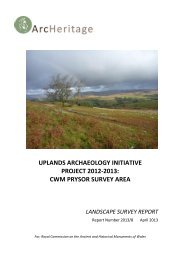
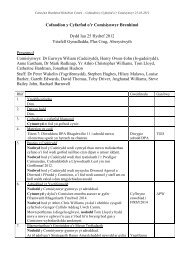
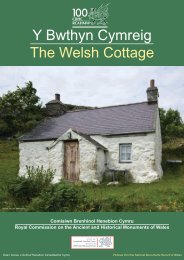

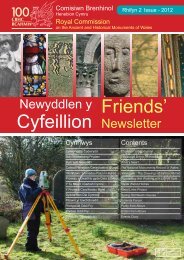
![The Source of the Usk Walk [2012 PDF]](https://img.yumpu.com/49285699/1/190x245/the-source-of-the-usk-walk-2012-pdf.jpg?quality=85)


